Research Brief: Measuring sexual violence against girls in Malawi requires multiple ways to get accurate data

Background
In order to prevent and respond to violence, reliable surveillance data are critical. Many studies use retrospective recall – asking people to report on their experiences in the past – to collect information about violence experience. As girls and women age, it would be expected that risk for lifetime experience of sexual violence would increase, but this has not been studied.
This study used 2013 Violence Against Children Survey (VACS) data from Malawi collected among girls ages 13-24. The study authors divided the sample into separate age groups: younger (ages 13-18) and older (19-24) girls. They then compared whether the experiences of sexual violence were different between these age groups, comparing experiences over the entire lifetime, in childhood, and in the past 12 months. The findings from this study can help researchers and public health officials understand how to interpret findings from population studies of sexual violence against girls and young women.
Key Findings
- Report of childhood sexual violence against girls increased from age 13 to age 18, but there was a drop off after age 18. This could be because older girls do not recall past incidents of violence, they may have been less likely to disclose violence experiences, or it could be a “cohort effect,” suggesting that younger girls are exposed to higher risks than in the older age group when they were younger.
- About 17% of the older (19-24) girls reported sexual violence in childhood, compared to 37% of the younger (13-18) girls.
- This study found variation in sexual violence reported by age group and by time frame – lifetime, childhood, or past 12 months. As a result, it is important to collect data on all three time frames, to gain an accurate picture of the prevalence as defined in different ways.
What is added by this report?
Finding the most accurate way to measure sexual violence against girls is important. Older girls may not always report higher rates of victimization, even though they have lived longer than younger girls. Prevalence of sexual violence should include data from lifetime, childhood, and in the past 12 months to get an accurate picture.
Fan AZ, Kress H, Gupta S, Wadonda-Kabondo N, Shawa M, Mercy J. Do self-report data reflect the real burden of lifetime exposure to sexual violence among females aged 13-24 years in Malawi? Child Abuse and Neglect 2016; 58: 72-79.
*Footnote: some variation between prevalence estimates from published papers and country reports may exist. This variation reflects slight differences in the subsamples and variables used in the analyses.